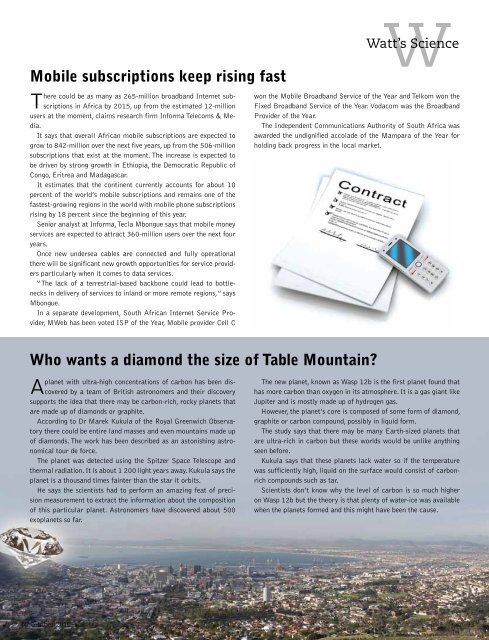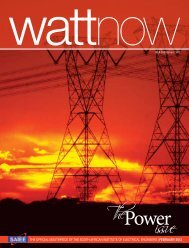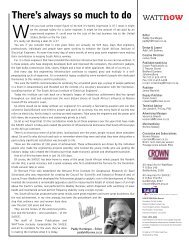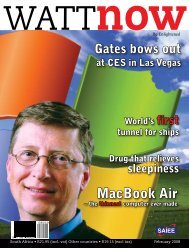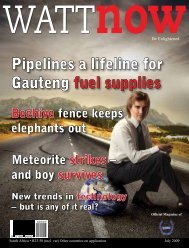download a PDF of the full November 2010 issue - Wattnow
download a PDF of the full November 2010 issue - Wattnow
download a PDF of the full November 2010 issue - Wattnow
Create successful ePaper yourself
Turn your PDF publications into a flip-book with our unique Google optimized e-Paper software.
Mobile subscriptions keep rising fast<br />
There could be as many as 265-million broadband Internet subscriptions<br />
in Africa by 2015, up from <strong>the</strong> estimated 12-million<br />
users at <strong>the</strong> moment, claims research firm Informa Telecoms & Media.<br />
It says that overall African mobile subscriptions are expected to<br />
grow to 842-million over <strong>the</strong> next five years, up from <strong>the</strong> 506-million<br />
subscriptions that exist at <strong>the</strong> moment. The increase is expected to<br />
be driven by strong growth in Ethiopia, <strong>the</strong> Democratic Republic <strong>of</strong><br />
Congo, Eritrea and Madagascar.<br />
It estimates that <strong>the</strong> continent currently accounts for about 10<br />
percent <strong>of</strong> <strong>the</strong> world’s mobile subscriptions and remains one <strong>of</strong> <strong>the</strong><br />
fastest-growing regions in <strong>the</strong> world with mobile phone subscriptions<br />
rising by 18 percent since <strong>the</strong> beginning <strong>of</strong> this year.<br />
Senior analyst at Informa, Tecla Mbongue says that mobile money<br />
services are expected to attract 360-million users over <strong>the</strong> next four<br />
years.<br />
Once new undersea cables are connected and <strong>full</strong>y operational<br />
<strong>the</strong>re will be significant new growth opportunities for service providers<br />
particularly when it comes to data services.<br />
“The lack <strong>of</strong> a terrestrial-based backbone could lead to bottlenecks<br />
in delivery <strong>of</strong> services to inland or more remote regions,” says<br />
Mbongue.<br />
In a separate development, South African Internet Service Provider,<br />
MWeb has been voted ISP <strong>of</strong> <strong>the</strong> Year, Mobile provider Cell C<br />
W<br />
Watt’s Science<br />
won <strong>the</strong> Mobile Broadband Service <strong>of</strong> <strong>the</strong> Year and Telkom won <strong>the</strong><br />
Fixed Broadband Service <strong>of</strong> <strong>the</strong> Year. Vodacom was <strong>the</strong> Broadband<br />
Provider <strong>of</strong> <strong>the</strong> Year.<br />
The Independent Communications Authority <strong>of</strong> South Africa was<br />
awarded <strong>the</strong> undignified accolade <strong>of</strong> <strong>the</strong> Mampara <strong>of</strong> <strong>the</strong> Year for<br />
holding back progress in <strong>the</strong> local market.<br />
Who wants a diamond <strong>the</strong> size <strong>of</strong> Table Mountain<br />
planet with ultra-high concentrations <strong>of</strong> carbon has been discovered<br />
by a team <strong>of</strong> British astronomers and <strong>the</strong>ir discovery<br />
A<br />
supports <strong>the</strong> idea that <strong>the</strong>re may be carbon-rich, rocky planets that<br />
are made up <strong>of</strong> diamonds or graphite.<br />
According to Dr Marek Kukula <strong>of</strong> <strong>the</strong> Royal Greenwich Observatory<br />
<strong>the</strong>re could be entire land masses and even mountains made up<br />
<strong>of</strong> diamonds. The work has been described as an astonishing astronomical<br />
tour de force.<br />
The planet was detected using <strong>the</strong> Spitzer Space Telescope and<br />
<strong>the</strong>rmal radiation. It is about 1 200 light years away. Kukula says <strong>the</strong><br />
planet is a thousand times fainter than <strong>the</strong> star it orbits.<br />
He says <strong>the</strong> scientists had to perform an amazing feat <strong>of</strong> precision<br />
measurement to extract <strong>the</strong> information about <strong>the</strong> composition<br />
<strong>of</strong> this particular planet. Astronomers have discovered about 500<br />
exoplanets so far.<br />
The new planet, known as Wasp 12b is <strong>the</strong> first planet found that<br />
has more carbon than oxygen in its atmosphere. It is a gas giant like<br />
Jupiter and is mostly made up <strong>of</strong> hydrogen gas.<br />
However, <strong>the</strong> planet’s core is composed <strong>of</strong> some form <strong>of</strong> diamond,<br />
graphite or carbon compound, possibly in liquid form.<br />
The study says that <strong>the</strong>re may be many Earth-sized planets that<br />
are ultra-rich in carbon but <strong>the</strong>se worlds would be unlike anything<br />
seen before.<br />
Kukula says that <strong>the</strong>se planets lack water so if <strong>the</strong> temperature<br />
was sufficiently high, liquid on <strong>the</strong> surface would consist <strong>of</strong> carbonrich<br />
compounds such as tar.<br />
Scientists don’t know why <strong>the</strong> level <strong>of</strong> carbon is so much higher<br />
on Wasp 12b but <strong>the</strong> <strong>the</strong>ory is that plenty <strong>of</strong> water-ice was available<br />
when <strong>the</strong> planets formed and this might have been <strong>the</strong> cause.<br />
<strong>November</strong> <strong>2010</strong> 33


